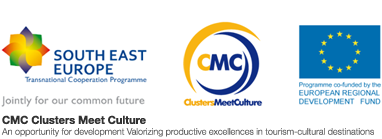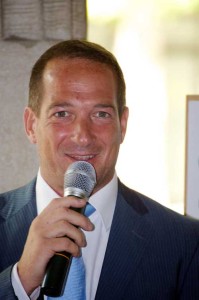An interview with Enrico Longo for CMC web site.
Enrico Longo creator of the Exhibition Centre of Archaeology of the Veneto Region. The Multimedia Exhibition Centre of Archaeology of the Veneto Region, at the Veneto Designer Outlet in Noventa di Piave, was born few years ago, through a public and private partnership including the Municipal Administration of Noventa, the management BMG, the Superintendence for Archaeological Heritage of the Veneto and Culture Active. The Multimedia Exhibition Centre of Archaeology of the Veneto Region is the showcase of the Venetian archaeological heritage. It promotes national museums and archaeological sites located in the Veneto Region, through interactive ICT tools. Moreover CEMA is located within the Noventa di Piave Outlet thus being a good example of synergy between culture and industry. Mr. Longo has been interviewed on the Clusters role in Europe and the possible benefit of the synergy between clusters and culture promoted by the CMC Project:
According to your opinion, a cluster needs to be formally recognized?
No it is not necessary for a cluster to be recognised in order to exist. There are many example of spontaneous created clusters because it is an initiative that need to be built in a spontaneous way on the territory.
Which are the main obstacles hindering clustering? What are the main success achieved?
Opportunities: higher self perception of common interests and logistic advantages. The cluster logically has to work on common infrastructures useful for all members. But Cema is not involved in any cluster. Main obstacles to the clusters activities: Their closure. Individualism of members.
How strong is creative and cultural industry in your region? How would you define it?
Yes it exist in Italy and can be defined a generic Made in Italy, recognised as a brand all over the world. Specific perception of Italian made in (fashion foe example) are clusters themselves (creative clusters).
How strong is tourism in your region and what development potentials can you see?
Yes tourism is well developed but not well organised, fragmented. It can be improved by giving to tourists an integrated and multiple offer. Localism and sectoral offers do not consider that there is a wider offer opportunity that could interest tourists in coming back the year after. In Veneto for example the seaside areas are not promoted as Italian seaside location but just promoted at local level. And some destination on the seaside in Veneto don’t promote at all the rest of the region (jealousy) because they want to maintain all the tourists in their little area. But this fact prevent tourists for coming back the year after. The Veneto region has a very diversified environment (seaside, dolomite mountains, city of culture, history) and well represents the potential touristic offer that Italy can propose to external tourists. Veneto Region could be promoted and sold as ‘Italy’ itself. Communication strategy should be improved.
In your opinion, are enterprises from the productive sector (industry) linked with the culture? Are donations to cultural activities from the private sector strongly developed (mecenate)?
The connection among the outlet industry and CEMA has been initially difficult, there where many concerns regarding the idea to create a multimedia museum inside the shopping area of the outlet. Now this idea will be exported in other outlet of the same brand to work on the tourist incoming also from new emerging economies such as China and Brazil. Concerning the proposed question: it is not easy to define what ‘culture’ is therefore it is not easy to answer to this question. To get known a specific territory to external touristic flows also on the basis of the industrial and productive tradition of that territory represents a challenge but also an opportunity. For example there are many entrepreneurs who open industrial museum into their own building.
Do you think Private public partnership could be a good tool to promote an integrated tourism promotion of the territory?
CEMA is a private initiatives financed by the private sector but defined in cooperation with the superintendence for cultural heritage and the ministry of culture (there is a specific agreement signed between the Ministry, Associazione Noventa Arte e Storia and Culture Active and the Outlet of Noventa). The Ministry provides material and authorise the utilisation of material. This can be defined as a PPP. The main challenge is to have an impact on the surrounding territories. (Forms of cooperation with public institutions: active cooperation (no financing) or sponsoring (Municipalities). Vantages to have enlarged partnership is to distribute promotional material through diversified channels.
What do you expect from the CMC project?
The main objective is to involve the industrial and productive sector and create a dialogue with them to find new connection among culture and industry through a figure such as the shopping trainer or the ICT platform, something that can propose a concrete integrated offer. For example wine production in Italy is strongly connected with the catholic cultural tradition of Italy. Production is therefore culture itself. Aggregate diverse kind of subjects on the territory around the productive world in order to initiate dialogue and collaboration.

